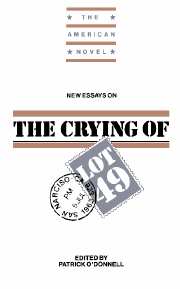Book contents
- Frontmatter
- Contents
- Series Editor's Preface
- 1 Introduction
- 2 Borges and Pynchon: The Tenuous Symmetries of Art
- 3 Toward the Schizo-Text: Paranoia as Semiotic Regime in The Crying of Lot 49
- 4 “Hushing Sick Transmissions”: Disrupting Story in The Crying of Lot 49
- 5 “A Metaphor of God Knew How Many Parts”: The Engine that Drives The Crying of Lot 49
- 6 A Re-cognition of Her Errand into the Wilderness
- Notes on Contributors
- Selected Bibliography
6 - A Re-cognition of Her Errand into the Wilderness
Published online by Cambridge University Press: 12 January 2010
- Frontmatter
- Contents
- Series Editor's Preface
- 1 Introduction
- 2 Borges and Pynchon: The Tenuous Symmetries of Art
- 3 Toward the Schizo-Text: Paranoia as Semiotic Regime in The Crying of Lot 49
- 4 “Hushing Sick Transmissions”: Disrupting Story in The Crying of Lot 49
- 5 “A Metaphor of God Knew How Many Parts”: The Engine that Drives The Crying of Lot 49
- 6 A Re-cognition of Her Errand into the Wilderness
- Notes on Contributors
- Selected Bibliography
Summary
In the meantime, in between time …
— Popular songWhere have you been in the uterim?
— Finnegans WakeIt is, to use a highly typical Pynchon word, rather “odd” that The Crying of Lot 49, a slim novella which, because he was short of cash, Thomas Pynchon dashed off for Esquire on time borrowed from a long haul of erecting the vast cathedral of Gravity's Rainbow, should have become an overnight classic. The Crying of Lot 49 remains, arguably, the most emblematic text of the American sixties, and one that, a quarter-century later, has best retained its magical spell over the reader. When this fictional UFO first fell from the strange skies of America, the effect, at least on the European side of the Atlantic, was definitely eerie and even downright (as we had not yet learned to say) “mind-boggling.” The few of us who had been there at all saw it as nothing more than a hilarious “black humor” cartoon of the current southern California's “freaked-out” scene. Some already knew about the Tibetan Book of the Dead, having read The Psychedelic Experience two years before and noticing Dr. Hilarius was obviously Timothy Leary scarcely transmogrified. This was the year when Dr. Leary, spurred on by Marshall McLuhan, coined his slogan “Turn On, Tune In, Drop Out” — and at the time this seemed a fairly adequate summary of the story told in The Crying of Lot 49.
- Type
- Chapter
- Information
- New Essays on The Crying of Lot 49 , pp. 127 - 170Publisher: Cambridge University PressPrint publication year: 1992
- 2
- Cited by



